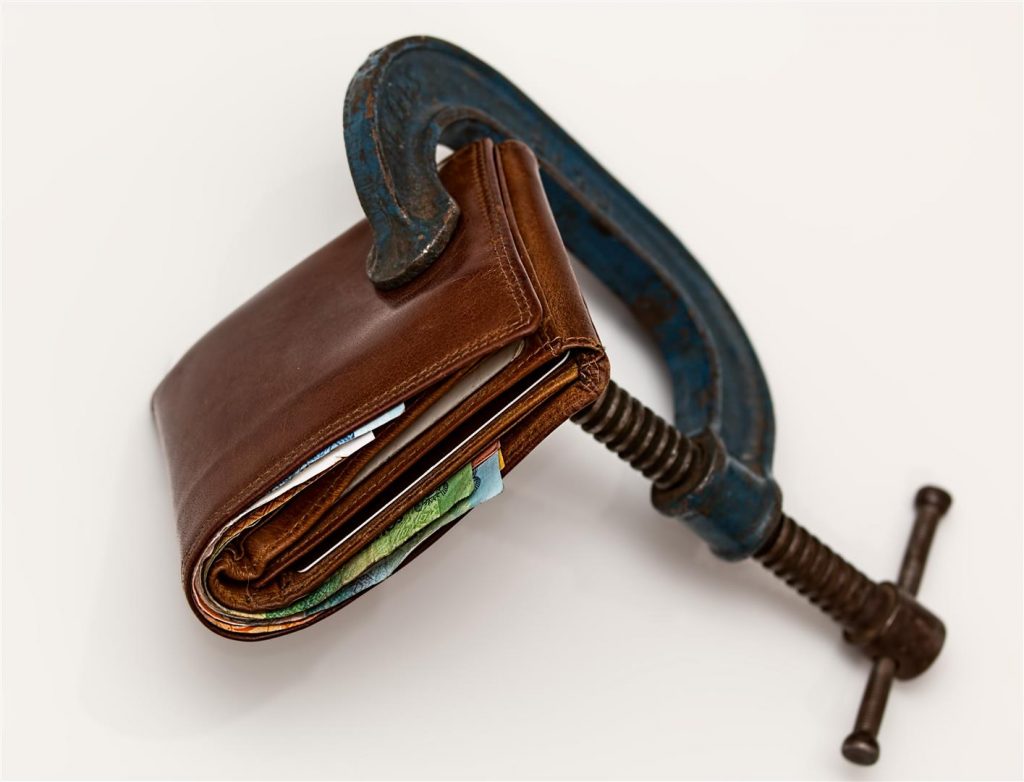Investment Retirement Accounts (IRAs) always made sense to me. A Traditional IRA lets you skip paying taxes on the money you contribute this year, but makes you pay taxes when you withdraw it at retirement. A Roth IRA uses taxed money when you contribute so you don’t have to pay taxes on the withdrawals when you retire.
With a Roth IRA, you can transfer funds which already have income taxes deducted – the money in your checking account after you deposit your paycheck or receive your direct deposit. You can transfer up to $5,500 each year into your Roth IRA if you’re younger than 50 and then $6,500 a year when you’re 50 and older.
The big bonus? You don’t pay any taxes on your withdrawals when you retire. Not a penny! Sounds like a great deal, right?
So, what was my problem?
For me, it was a huge misunderstanding of when I could take the money out. I always thought the money I put into my Roth IRA was locked away until I was 59½ years old (in my research, the IRS basically chose this number as the start point from a combination of formulas and just picking it out of the thin, blue air).
I thought I couldn’t withdraw even my contributions without taking a penalty so I was hesitant to maximize how much money I put in my Roth IRA each year for fear I’d have an emergency like a health issue, house repair, or something unforeseen which would make me wish I never put the money into the Roth to begin with.
It turns out I was wrong. Very, very wrong.
Unlike a Traditional IRA where you can’t withdraw funds early without paying taxes and fees because Traditional IRA contributions are made pre-tax, with a Roth IRA, you can withdraw your contributions at any time for any reason with no penalty.
Where was the confusion? You can’t withdraw any earnings from the account without penalties before you’re 59½ years old.
Let me put it this way: as long as you keep track of how much money you’ve put in, you can always get that money back out with no penalties.
Before I internalized this key bit of knowledge – that I could get my contributions back at any time if I really needed them – I looked at Roth IRAs as a secret lock-box preventing me from ever getting to my money again until I retired lest I be attacked with huge penalties and fees, even if I had an emergency and had nowhere else to get funds.
Nothing could be further from the truth.
Your Roth IRA is truly a savings account, however you should only use it for true emergencies. We’ll go into why later in this article.

What does this mean?
This means you should try to deposit the annual maximum into your Roth IRA every year if at all possible.
For me, when I thought about it, I realized I’ve never actually had an emergency where I needed the extra funds I was keeping liquidated in my savings account earning little to no interest but easily accessible.
Now, rather than keeping that extra money in my savings account and missing out on maximizing my Roth IRA contributions, I make sure I maximize my Roth contributions every year at all costs by putting money I’d normally store in my savings account into my Roth IRA.
Sure, I don’t want to withdraw the contributions, but now I take advantage of the annual contribution limit, and, if I ever do have an emergency, I can reluctantly withdraw from my Roth IRA at that point. In the meantime, I will have maximized my Roth IRA and be making as much money as possible for my retirement in a tax-free account.
Basically, think of your Roth IRA as your “only-for-emergencies” savings account. Maximize your annual contributions remembering that although you really, really don’t want to withdraw your contributions, you can withdraw them without penalty if you have absolutely nowhere else to turn.
Plus, I’m earning a heck of a lot more than the measly 1.2% interest rate I get on my savings account. With inflation at 2%, a 1.2% interest rate means I’m losing 0.8% each year!
If I withdraw my contributions, can I put them back in once I’ve saved them back up?
No. This is the key difference between a Roth IRA and a normal savings account and why you should be very cautious about withdrawing your contributions. You cannot “catch up” your Roth IRA.
On the bright side, you can continue to make deposits into your Roth IRA for the current tax year up until April 15 of the next tax year. This helps in situations where you have more expenses than you expected one year, but then get a windfall by April 15 of the next year (like, say, a tax refund or a raise).
Remember: you can only contribute up to the annual maximum limit ($5,500/yr < 50 and $6,500/yr > 50) each year into your Roth IRA, even if you’ve withdrawn contributions in prior years. Once you’ve missed the time to make your maximum contribution for a year (April 15 of the next year) or you withdraw a contribution, the opportunity to make the maximum contribution for that year is gone forever.
You can replace the withdrawal within the same year you withdrew it or by April 15 of the next year, but, again, only up to the annual maximum even if you withdrew more than the limit. This is why you should think of your Roth IRA as an “emergency-only” savings account: you really don’t want to pull any of your contributions back out unless you absolutely, positively have to.
Basically, the easiest way to think of your Roth is that if you pull out contributions, you’re making a permanent deduction from your retirement income.
How will a Roth IRA help me in retirement?
By not having to pay taxes on your earnings – the capital gains tax rate is 15% in 2017 – you can potentially save thousands on your tax bill.
Let’s take a look at four Roth IRA examples starting at ages 24, 30, 40, and 50 using the following four assumptions:
- You’re retiring at 67. You’re going to retire at age 67 when full Social Security benefits start (if they still exist by that point).
- You’ve maximized your contributions. You’re maxing out your Roth IRA deposits each and every year – $5,500 annually up until age 50 and then increasing your contributions to $6,500 each year from 50 on.
- Your average rate of return is 7% annually. Let’s assume your Roth IRA earns an average annual rate of return of 7%, a relatively conservative estimate. For example, the average rate of return for the S&P 500 from its inception in 1926 through 2011 was 11.69% annually. Yes, 11.69% earned each year. You’re about to see the magic of “compounded interest” – this is when you make 7% on the 7% you earned the previous year, and so on, and so on.For ease of calculation, we’re assuming you put your entire contribution at the very end of each year so you’re only making 7% on the previous year’s balance rather than making gains on your contributions if you choose to make them regularly throughout the year. Doing this results in a more conservative and more likely estimate of your overall success.
- You’re going to take out 4% annually. Once you retire, you’re going to withdraw 4% of your account balance annually as income. This is the conservative withdrawal rate retirement advisers use to ensure you will have consistent income during retirement and not run out of cash before you kick the bucket (morbid, yes, but equally important, too!).
For those of you who enjoy charts:
| Starting Age | Account Balance at Age 67 | Tax Savings | 4% Annual Withdrawal | Monthly Income |
| 24 | $1,497,663.71 | $185,649.56 | $59,906.55 | $4,992.21 |
| 30 | $983,084.64 | $113,412.70 | $39,323.39 | $3,276.95 |
| 40 | $477,836.33 | $45,875.45 | $19,113.45 | $1,592.79 |
| 50 | $220,993.71 | $15,599.06 | $8,839.75 | $736.65 |
For those of you, like me, who prefer to read:
Full annual contributions starting at 24 years old:If you start making the maximum annual contributions to your Roth IRA at age 24 and keep it up ($5,500 a year until age 50 and then $6,500 a year from 50 on to retirement), you’ll earn $4,992.21 a month when you retire at age 67 with $1.5 million in your account! Also, remember that the $4,992.21 you get each month is your actual income after taxes thanks to Roth IRAs taking taxes on the way in, not the way out. Your Roth IRA saved you a tax bill of $185,649.56 on your earnings at a 15% capital gains tax rate! |
Full annual contributions starting at 30 years old:Wait just six years until you’re 30 to start funding your Roth IRA, and your monthly retirement income potential drops by 34.36% to $3,276.95 a month when you retire at 67. You’ll have about a million dollars in your Roth IRA and you will have saved $113,412.70 in capital gains taxes! |
Full annual contributions starting at 40 years old:Maybe you’re like me, and you get a really slow start on your Roth because you didn’t fully get it, and you don’t start contributing at all until you reach your “biggest earning years” beginning at age 40. By age 67, your potential income is $1,592.79 a month – a drop of 51.4% from where it would be for someone who started at age 30 and a heart-stopping 68.1% plummet from where you could have been if you started saving just 16 years earlier at age 24. What a difference a few years make! That being said, you’ll still have almost a half-million in your account plus you’ll have saved $45,875.45 in capital gains taxes! |
Full annual contributions starting at 50 years old:You’re never too old to start a Roth! Even at age 50, if you start at zero and put $6,500 away each year (the annual maximum for those 50 and older), you will still net an extra $736.65 a month in tax-free retirement income by the time you’re 67! In your account, you’re earning a whopping 85.24% less than you could have had if you started contributing at age 24, but you will have about $220,000, no small feat in just 17 years! Better yet, you’ll have saved $15,599.06 on capital gains taxes! |
This sounds great, but how do I get at least 7% in earnings each year?
A Roth IRA is just an interest-free savings account if you don’t put the money to work. If you don’t invest the money, it will just sit there not earning a red cent.
This means you’ll only have what you contributed by the time you retire. Knowing that the average inflation rate is about 2%, this means you’re essentially losing money letting it sit there. Ever heard the phrase, “make your money work for you?” You’ve got to get that money a job!
Fortunately, there are a myriad of options for how you choose to invest your Roth IRA funds: you can buy individual stocks, mutual funds, and Exchange Traded Funds (ETFs). You can also invest in startup companies and sometimes you can even buy real estate, all from inside your Roth IRA. There are more investment options available than just these, too!
What if I don’t want to manage my own Roth IRA and how do I get started?
If you don’t have the interest, time, or skill to micro-manage your own Roth IRA, you can have someone else do it – an investment adviser.
You can open up a Roth IRA with the big banks like J.P. Morgan Chase, Bank of America Merrill Lynch, Charles Schwab, and many more who offer wealth management services where they’ll handle the investment decisions for your Roth IRA. Of course, nothing’s free and the big banks carry annual management fees usually around 1.5% of your account balance (that’s $1,500 a year per $100,000).
Going with that kind of adviser, you’ll need to earn an average 7% rate of return plus the management fee (in this case, 1.5%) for a total average return of 8.5%. This is still doable considering the S&P historically earns an average 11.69% a year give or take, but it’s definitely not as easy to earn 8.5% as it is to earn 7%.
In recent years, a new kind of wealth management service has become popular – robo-advisers.
Robo-advisers automatically trade in and out of a variety of investments using algorithms (formulas/strategies) and regular rebalancing (making sure your investments are balanced by adjusting your portfolio to earn the greatest rate of return). Robo-advisers invest in a variety of investment types typically including the U.S. stock market, international stock markets, emerging market bonds, high-yield bonds, municipal bonds, and more.
Better still, robo-adviser fees are often less than 1% annually. SoFi.com and Wealthfront.com, for instance, both offer free management for account values up to a certain amount and then charge a marginal fee per year above that – less than a half-percent.
If you only have a 0.25% robo-adviser fee, you only need to earn 7.25% annually, not the 8.5% you’d need to earn with a traditional adviser.
Robo-advisers let you pick your own level of risk based on how much risk you can stomach ranging from Conservative, Moderately Conservative, Moderate, Moderately Aggressive, and Aggressive. The younger you are, the higher your risk tolerance should be as you have the time to make the money back should something go terribly wrong.
That being said, if you’re getting started at an older age (like me, cough cough), you might want to go for higher risk since you might have a lesser chance of retiring if you get a conservative return. Just remember that a higher return means you’re taking a higher risk – you might lose money. But, as the old guys say, “It takes money to make money!”
What are the lessons here?
Let’s recap the major points:
- Max out your Roth IRA! If you’re not already, start contributing the annual maximum to your Roth IRA today! Whether you manage the account yourself or have someone else do it, it’s your best shot at reliable tax-free retirement income!
- You’re never too old to start a Roth IRA! Make your annual Roth IRA contributions regardless of your age. There’s an old adage/joke that works here: “When’s the best time to plant a tree? 20 years ago. When’s the second-best time to plant a tree? Today!”
- Roth IRAs are not black holes! Don’t think of Roth IRA contributions as money that’s locked away. Think of your Roth as your “definitely-only-for-emergencies” savings account. I even include my Roth IRA contributions (not the earnings, mind you) in my financial software so I can track my Roth contributions as part of my accessible net worth.
For me, this small change in how I think about Roth IRAs has transformed my entire approach to retirement planning. Hopefully, it will do the same for you, too!
Do you have questions or suggestions that might help other readers? Please feel free to leave them in the comments!
About Irk:
Eric “Irk” Jacobson started using computers when he was 3 years old with an Apple IIe. He tries to be device-agnostic using all kinds of technology from all of the major players, and he loves/hates them equally in different ways. Eric Jacobson is a Public Relations and Communications Professional specializing in helping businesses, school districts, and municipalities build communications plans, engage in community feedback, and achieve their goals for success.
When not working hard, Eric’s an avid motorcyclist, a hardcore gamer, and a massive finance and statistics nerd playing the stock market and tracking his finances religiously – like, watching Fast Money and Mad Money daily on CNBC while looking at his accounts multiple times every single day and tracking every transaction he makes down to the penny (say it with me -“Obsessive, much?”).
Check out our newest venture!
Get Irked is a small community made up of helpful, friendly and motivated investors and traders of all levels looking to reach the same goal - the ability to invest profitably in order to achieve financial independence.
Investors of all experience levels are welcome.
www.GetIrked.com






